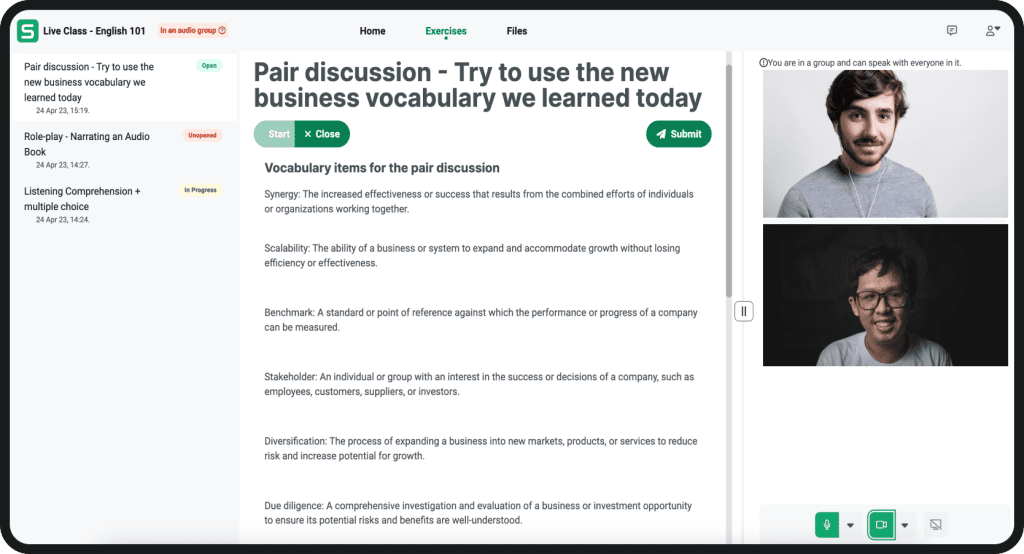Amongst all the talk about different language teaching approaches, it is important to remind ourselves that language teaching does not work when viewed as “one size fits all.” It is vital to recognise that all students are at different points in their learning journey and that a personalised and tailored plan is required to help them to achieve their goals and potential.
It’s also important that students are in classes with other students at their level – it can otherwise be difficult to maintain engagement and motivation if the content is either too difficult or too easy.
In order to do this, educators first need to identify what level of proficiency each student currently has. Educators can then plan how best to help them improve. This blog post therefore looks at how students’ proficiency level can be identified and outlines how educators can then tailor their teaching and resources to best support each student.
What are the different levels of language proficiency?
There is a wide variety of standards and tools used to measure and describe a language learner’s proficiency level. But many teachers and experts around the world use the Common European Framework of Reference for Languages (CEFR).
Although developed by the Council of Europe, the CEFR is used all around the world and provides the most widely accepted ability mark. It is a highly practical tool that uses neutral language which can be applied to learners of any language. The CEFR can also be used to organise study content in classes, curriculum, learning resources and exams.
The CEFR language levels provide universally understood descriptions of the proficiency of a student’s oral and written expression and language comprehension. They are recognized and used throughout academia, by language schools and textbook publishers, but can also be used professionally. They are a common sight on CVs, LinkedIn profiles as well as in job advertisements.
The CEFR scale is organized into six different levels of proficiency (A1, A2, B1, B2, C1, C2). They range from beginner (A1) to very advanced (C2). They can also be divided into three broader levels: Basic User, Independent User and Proficient User.
The detailed description of each proficiency level can be found on the CEFR website here, so a summary of the broad levels is provided below.
Basic Users (A1 and A2): Are able to communicate in everyday situations with commonly-used expressions and elementary vocabulary.
Independent Users (B1 and B2): Have the necessary fluency to communicate without effort with native speakers.
Proficient Users (C1 and C2): Learners who are able to perform complex communication tasks, typically related to work and/or study.
How do I know what level each student is at?
Most informal language teaching institutions will offer a CEFR test to assess a student’ proficiency when they start. This ensures that they join a course pitched at the right level. Experienced practitioners will invariably be able to identify what level a learner is at from just a brief conversation or task!
Such standardized tests are freely available from expert providers such as Cambridge English and EF. Learners may also wish / need to take a standardized English proficiency test (e.g IELTS) to demonstrate their English level for academic, work, or immigration purposes. These tests do have their own learner levels, but they are also mapped to the recognised CEFR levels outlined above.
A wide range of similar tests exist for global languages such as the HSK Chinese Proficiency Test. Official language bodies like the Alliance Française for French or the Instituto Cervantes for Spanish will also be able to advise on appropriate tests for other popular languages.
How can I tailor my teaching to each student’s CEFR level?
Knowing the proficiency levels of your learners is obviously crucial for language educators. This provides a good indication of what students may or may not be able to do in class from the very beginning of the course. It also enables the educator to select appropriate language learning activities and materials and tailor them to each student’s level.
Teaching basic learners in any language can be a huge challenge, given that they usually have very limited pre-existing knowledge to build on. It is essential therefore to provide a clear and simple pathway to help them quickly build confidence and competence. Teachers typically focus on learning essential vocabulary such as family names (e.g mother, wife, son), household objects (e.g door, fork, bed), basic adjectives (e.g hot, cold, light and dark) and place names (e.g shop, school, bus stop). From a grammar perspective, students usually begin by expressing modality (e.g. I want, I can, I must) and building simple sentences and learning how to ask questions.
Props, pictures and real-life objects (e.g. keys, books, food etc) can be a good way to relay meaning without confusing students. They work well for learners of all ages and are applicable across most countries. The Total Physical Response (TPR) approach is also widely used, in which teachers use their body and facial expressions to relay meaning and build vocabulary.
Independent learners have mastered the basics and are usually able to talk and write fluently about familiar topics such as family and hobbies. They’re also able to use their language skills when travelling or in conversation with native speakers. Their biggest challenge is often related to confidence – they know that they have acquired some skills, but appreciate there’s still lots that they don’t know!
It’s vital for teachers to keep these learners moving forwards. Maximise opportunities for them to practice their key skills (listening, reading, speaking and writing) with peers and where possible with native speakers. Make extensive use of authentic media (e.g. menus, timetables, newspapers) to ensure that their learning is always relevant and based on real-life scenarios. Encourage them to read novels in their target language and to watch films on Netflix without the subtitles on!
Proficient users are often close to native speaker level. These students can communicate very fluently and precisely and can understand almost everything they hear or read. Yet they may still benefit from the presence for a teacher or the structured learning environment of the classroom.
At this stage, it can pay dividends to really focus on their specific needs – understand if your students are working for a qualification or residency and build your lessons to help and support them. Maybe run one-to-one sessions to iron out any outstanding issues in grammar or pronunciation? Advanced learners could also be encouraged to share their knowledge with less proficient learners, even acting as a teacher for a lesson or a day. In particular, advanced learners will benefit from continued immersion in their target language, especially through a stay in-country to build confidence and fluency in a variety of settings.
How can Sanako help?
Sanako’s range of language teaching tools have been developed with and for teachers and for use in the full range of education settings.
For example, our highly flexible web-based language teaching platform Sanako Connect, allows teachers to tailor their resources as well as their chosen teaching method for each class or group of students. The teacher can easily upload learning material that aligns with the specific language skills and vocabulary required for each language level. For instance, an A1 learner might need to focus on basic greetings and everyday phrases, while a C1 learner might need to dive into nuanced topics, idiomatic expressions, and complex grammar. Sanako Connect software can be used for multimedia content such as videos, audios, gap-fill, and interactive writing exercises specifically designed to practice and enhance these skills at each level.
For independent and proficient language learners (from B1 to C2), Sanako Connect is the ideal teaching tool to support progress in the classroom and remotely. This tool enables students to maximise the time spent in active language learning and enable teachers to easily manage speaking and pronunciation based lessons effectively. Students can be easily assigned to live pairs and groups and can work through different exercises that have been designed for their individual needs and level. We also have an automated pronunciation practice feature that allows students to practice repeating native-like speech models and get immediate and automated feedback. You can read more about this automated pronunciation grading feature here.
Sanako is the global-leader in teacher-led language instruction technology. Our software supports language teachers to deliver inspiring and effective lessons. If you’d like to find out more about how Sanako’s dedicated language teaching software could transform your approach to language teaching, click here or the banner below to learn more!
This blog post was last updated 1 September, 2023.



